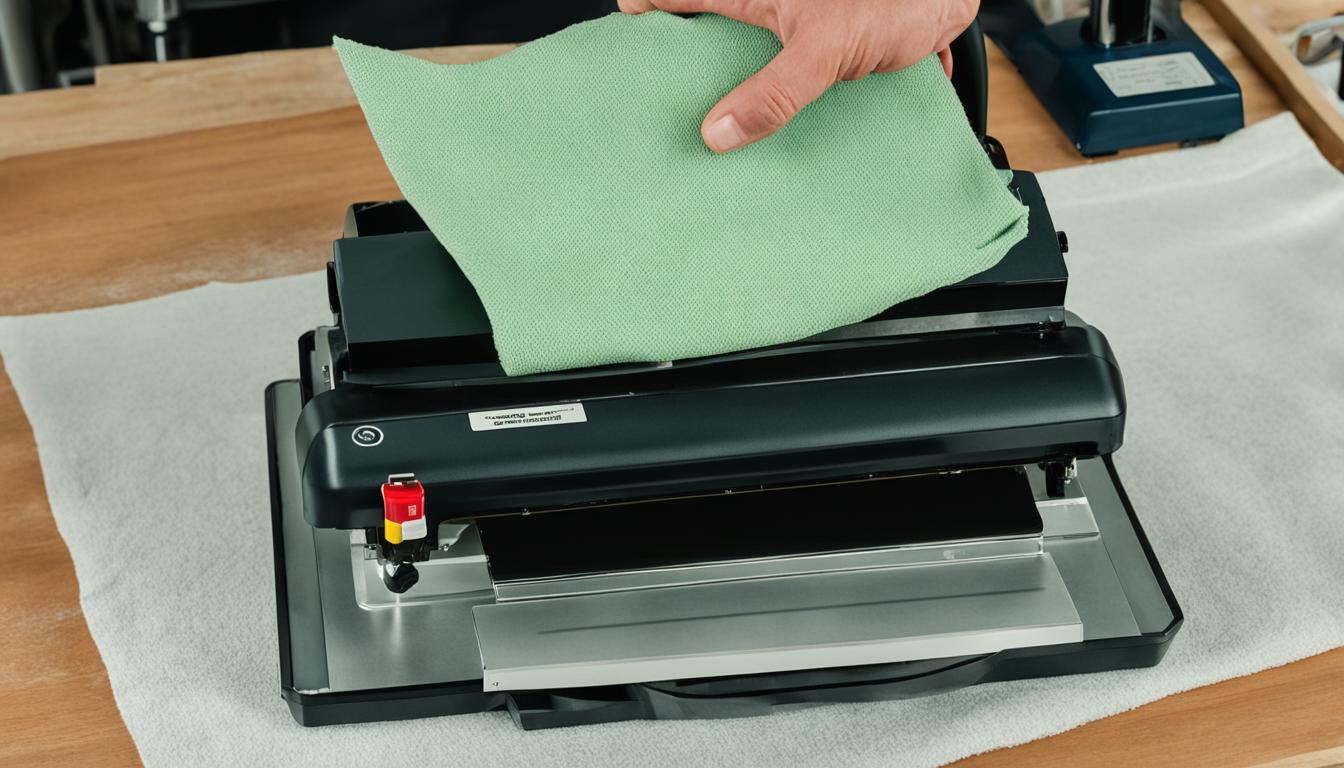Cleaning a heat press is essential for optimal performance and longevity. In this easy-to-follow guide, I will provide quick tips and best practices on how to clean a heat press machine effectively. Whether you have a Cricut heat press, need to remove sublimation ink, or just want to keep your heat press clean, these tips will help you achieve the best results.
Key Takeaways:
- Regular cleaning and maintenance ensure optimal performance and longevity of your heat press machine.
- Proper cleaning leads to even heat distribution and consistent, high-quality transfers.
- Use non-abrasive cleaners like mild soap and water to clean the heat plate and avoid damaging the surface.
- Protect your heat press surface with a heat press mat or cover to prevent damage and make cleaning easier.
- Follow manufacturer instructions for cleaning specific heat press models, such as the Cricut EasyPress.
The Importance of Cleanliness for Heat Press Machines
Maintaining a clean heat press machine is crucial for several reasons. First, a clean machine ensures that the heat is evenly distributed, resulting in consistent and quality transfers. Second, regular cleaning prevents the buildup of residue, which can affect the adhesion of transfers. Lastly, proper cleaning and maintenance contribute to the longevity of your heat press, saving you money in the long run.
When a heat press machine is clean, the heat distribution is optimized, and this is essential for achieving professional-quality results. Without proper cleaning, residue can accumulate on the heat plate, causing uneven heating and ultimately affecting the quality of transfers. By implementing best practices for heat press cleaning, you can avoid these issues and ensure that your machine operates at its best.
Cleaning a heat press machine is not a complex task, but it requires regularity and attention to detail. By following the proper heat press cleaning technique, you can maintain a clean heat press and enjoy the benefits of consistent, high-quality transfers.
In the next section, we will explore the best practices and techniques for cleaning a heat press machine, ensuring that you have the knowledge and tools necessary to keep your machine in optimal condition.
Benefits of a Clean Heat Press Machine
| Benefits | Description |
|---|---|
| Even heat distribution | A clean machine ensures that heat is evenly distributed across the heat plate, resulting in consistent transfers. |
| Prevents residue buildup | Regular cleaning prevents the accumulation of residue that can affect the adhesion of transfers. |
| Longer lifespan | Proper cleaning and maintenance contribute to the longevity of a heat press machine, saving you money in the long run. |
Cleaning the Heat Plate
The heat plate is a critical component of a heat press machine. It is important to keep the heat plate clean to ensure optimal performance and high-quality transfers. Here are some steps to effectively clean a heat press plate:
- Turn off the heat press and allow it to cool down completely. This is important for safety and to prevent any damage to the machine or yourself.
- Once the heat press is cooled, take a soft cloth or t-shirt and dampen it with mild soap and water. Make sure the cloth is not abrasive as it can scratch the surface of the heat plate.
- Gently wipe the heat plate using the damp cloth to remove any residue or dirt that may have accumulated. Pay extra attention to any stubborn spots or stains.
- If there is stubborn residue that cannot be removed with soap and water, you can use a commercially available iron cleaner specifically designed for heat press plates. Follow the instructions on the cleaner and use it sparingly, making sure to wipe away any excess cleaner with a clean cloth.
- Do not use abrasive cleaners or scrub brushes on the heat plate as they can damage the surface and compromise its functionality.
- After cleaning, ensure that the heat plate is completely dry before using the heat press again.
Regularly cleaning the heat plate will help maintain its performance and ensure that your heat press operates at its best. Keeping the heat plate clean prevents residue from transferring to your transfers, resulting in high-quality and professional-looking prints.
Remember to follow the manufacturer’s instructions for cleaning your specific heat press model, as different machines may have different cleaning requirements.
“A clean heat plate leads to flawless transfers.”
Protecting Your Heat Press Surface
To protect your heat press surface and keep it clean, consider using a heat press mat or cover. These accessories not only provide a barrier between the heat press and the transfers but also help to absorb excess heat and prevent damage to your work surface.
Using a heat press mat or cover can have multiple benefits. Firstly, it adds a layer of protection to your heat press, safeguarding it from accidental scratches or spills. Additionally, the mat or cover can help to minimize the risk of residue transfer, making the cleaning process easier and more efficient. By using a heat press mat or cover, you can avoid the need to clean the heat press surface as frequently.
“Using a heat press mat or cover can have multiple benefits.”
When choosing a heat press mat or cover, opt for one that is specifically designed for this purpose. Look for a product that is heat-resistant and offers sufficient thickness to prevent heat from transferring to your work surface. Additionally, make sure that the mat or cover is easy to clean to maintain proper hygiene.
Using a heat press mat or cover can significantly extend the lifespan of your heat press machine, as it provides an extra layer of protection against wear and tear. It also makes the cleaning process more manageable and reduces the risk of residue buildup.” – Heat Press Pro
In addition to using a heat press mat or cover, consider using an easy-to-clean cover sheet when transferring designs onto your materials. A cover sheet acts as a protective barrier between the heat press and the transfer, preventing any residue or ink from directly contacting the heat press surface. This not only helps to keep your heat press clean but also ensures that your transfers are of the highest quality.
Remember, maintaining a clean and protected heat press surface is crucial for achieving consistent and professional heat transfers. By investing in a heat press mat or cover and using a cover sheet during transfers, you can prolong the life of your heat press and simplify the cleaning process.
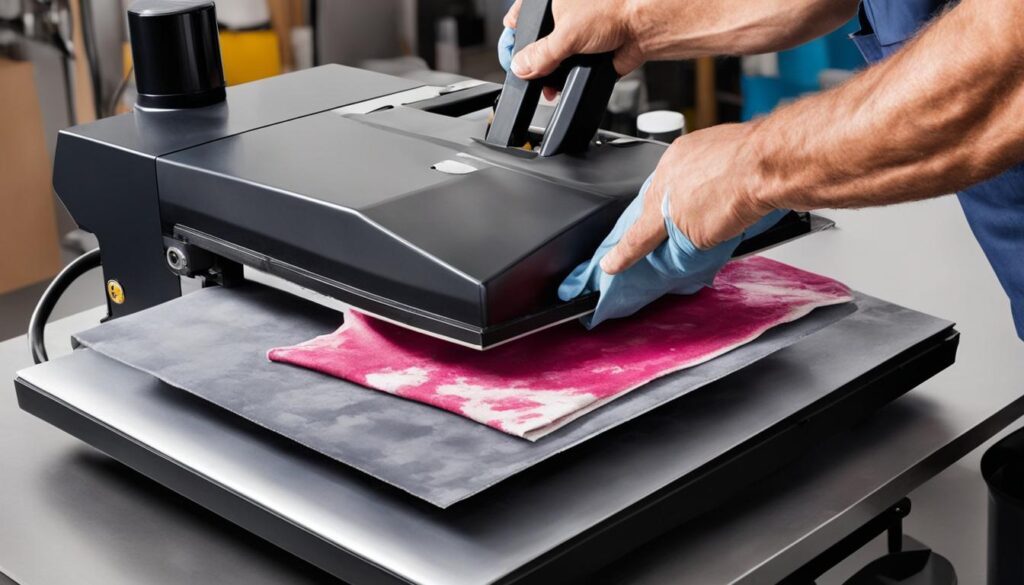
Removing Sublimation Ink
If you work with sublimation ink, there may come a time when you need to remove it from your heat press. Whether you want to clean the ink residue or switch to a different color, it’s essential to know the proper technique. Here’s a step-by-step guide on how to clean sublimation ink off your heat press:
- Turn off the heat press and allow it to cool down completely. This step is crucial for your safety and the effectiveness of the cleaning process.
- Take a cloth and dampen it with either isopropyl alcohol or a sublimation ink remover. Both options work well for removing sublimation ink without damaging the heat press.
- Gently wipe the cloth over the areas with sublimation ink. Use light pressure and circular motions to lift the ink off the surface. Avoid rubbing too hard or using abrasive materials that can scratch or harm your heat press.
- Repeat the process as needed until all traces of sublimation ink are gone. Remember to frequently change the cloth or clean it to prevent smearing the ink around.
By following these steps, you can effectively clean sublimation ink off your heat press and ensure its optimal performance. Remember to always handle the heat press with care and use suitable cleaning materials to protect its longevity.
If you need further assistance or encounter any difficulties, consult your heat press manufacturer’s guide or reach out to their customer support for more specific instructions.
Maintaining Proper Pressure and Heat Distribution
Alongside regular cleaning, ensuring proper pressure and heat distribution is crucial for optimal heat press performance. Cleanliness plays a significant role in this aspect, as any residue or debris on the heat plate can negatively impact pressure and heat distribution. To guarantee that your heat press operates at its best, it is essential to follow preventative maintenance measures.
One important heat press maintenance tip is to regularly inspect the pressure adjustment knob or control. This component allows you to adjust the pressure applied during heat transfers. Over time, the pressure adjustment mechanism may become loose or require calibration.
Here are a few heat press cleaning tips and maintenance techniques to help you maintain proper pressure and heat distribution:
- Inspect the heat plate regularly: Check the heat plate for any residue, debris, or damage. Use a soft cloth or t-shirt and mild soap and water to clean the surface, ensuring it is free of any buildup before each use.
- Calibrate the pressure adjustment knob: Follow your heat press manufacturer’s instructions to calibrate the pressure adjustment knob or control if necessary. This ensures consistent and accurate pressure during heat transfers.
- Check the platen alignment: Verify that the platen is properly aligned with the heat plate. Misalignment can lead to uneven heat distribution and pressure. Consult your heat press instruction manual for guidance on adjusting the platen if needed.
- Use heat-resistant tape: For precise heat distribution, you can use heat-resistant tape to secure your transfer materials in place. This tape helps to maintain consistent pressure and heat across the entire transfer area.
- Perform regular maintenance: In addition to regular cleaning, perform routine maintenance tasks such as lubricating moving parts and inspecting the machine for any signs of wear or damage. This helps to ensure smooth operation and extends the lifespan of your heat press.
Quote:
By maintaining proper pressure and heat distribution, you can enhance the quality and longevity of your heat press, resulting in professional and consistent heat transfers.
Regularly cleaning your heat press and implementing preventative maintenance practices will not only optimize heat distribution and pressure but also contribute to the overall performance and lifespan of your machine.

Cleaning the Heat Press Exterior
While cleaning the heat plate is important, don’t forget to clean the exterior of your heat press. Maintaining a clean exterior not only enhances the aesthetic appeal of your machine but also helps prevent the transfer of dirt and dust onto your transfers. Follow these heat press cleaning instructions to keep the exterior of your machine in pristine condition.
Step 1: Begin by turning off the heat press and unplugging it from the power source. Safety should always be a priority when cleaning any electrical appliance.
Step 2: Fill a basin or bucket with warm water and dilute mild dish soap. The gentle soap will effectively clean the surface without causing damage or leaving behind a residue. Avoid using harsh chemicals or abrasive cleaners that can strip away the paint or protective coatings.
Step 3: Dampen a clean cloth or sponge with the soapy water solution. Gently wipe down the outer surfaces of the heat press, including the sides, top, and control panel. Pay attention to areas where dirt, dust, or fingerprints may accumulate.
Step 4: For stubborn stains or residue, you can use a non-abrasive cleaning solution specifically designed for heat press machines. Apply the solution to the cloth or sponge, and then gently scrub the affected areas.
Step 5: After cleaning, rinse the cloth or sponge with clean water and use it to remove any soapy residue from the heat press. It’s essential to ensure no soap or cleaning solution remains on the surface.
Step 6: Finally, use a dry cloth or towel to wipe down the heat press, removing any excess moisture. This step will help prevent water spots or streaks from forming on the exterior.
Quick Tips:
- Do not spray water or cleaning solution directly onto the heat press. Always apply it to the cloth or sponge first.
- Avoid using abrasive materials such as scrub brushes or abrasive sponges, as they can scratch the surface of the heat press.
- Never immerse the heat press machine in water or expose it to excessive moisture. This can damage the electrical components and lead to malfunctions.
By following these heat press cleaning instructions, you can maintain the cleanliness and overall appearance of your heat press machine. Remember, a well-maintained exterior not only extends the lifespan of your heat press but also contributes to the professional quality of your heat transfers.
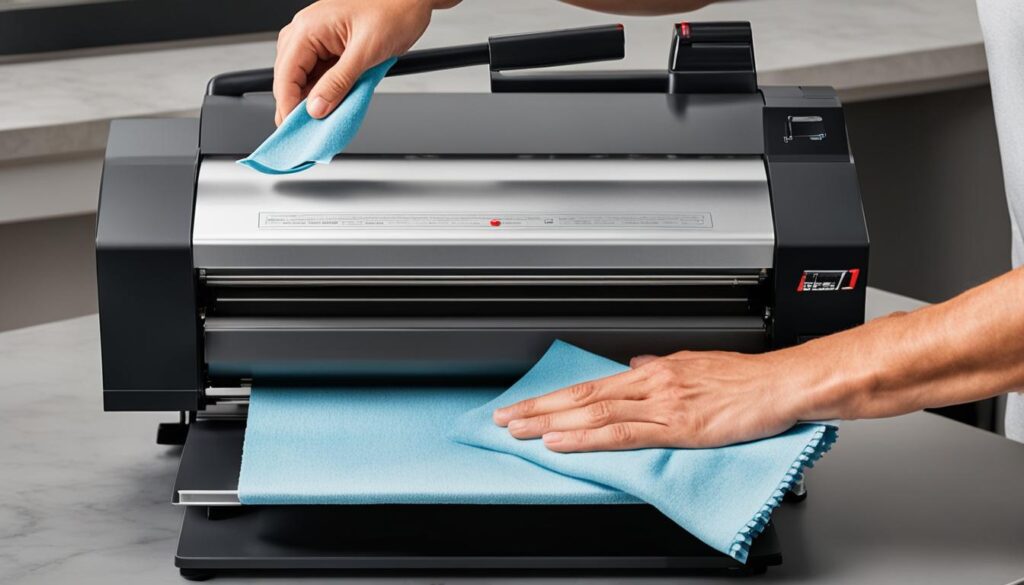
| Cleaning Step | Description |
|---|---|
| Step 1 | Turn off the heat press and unplug it. |
| Step 2 | Mix mild dish soap with warm water. |
| Step 3 | Use a cloth or sponge to wipe down the exterior surfaces. |
| Step 4 | For stubborn stains, use a non-abrasive cleaning solution. |
| Step 5 | Rinse the cloth or sponge with clean water and remove any soapy residue. |
| Step 6 | Dry the heat press with a towel to prevent water spots or streaks. |
Proper Storage and Maintenance Practices
Proper storage and maintenance practices are essential for prolonging the lifespan of your heat press machine. By implementing these guidelines, you can ensure that your heat press remains in optimal condition for years to come.
Storage
When your heat press is not in use, it’s crucial to store it in a clean and dry area. This helps to prevent dust, dirt, and moisture from accumulating on the machine, which can negatively impact its performance. Additionally, covering your heat press with a protective dust cover or cloth adds an extra layer of protection against potential contaminants.
Maintenance
Ongoing maintenance tasks are vital for keeping your heat press in excellent working condition. Here are some essential maintenance practices to follow:
- Regularly inspect the machine for any signs of wear or damage, such as frayed cords or loose components. Address any issues promptly to avoid further damage.
- Lubricate the moving parts of your heat press as recommended by the manufacturer. This helps to ensure smooth operation and prevent unnecessary strain on the machine.
- Check and tighten screws and bolts periodically to keep all parts securely in place.
By incorporating these maintenance practices into your routine, you can prevent potential problems and extend the life of your heat press machine.

“Regular maintenance is like giving your heat press a little love and attention. It pays off in the long run, helping you avoid costly repairs and ensure consistent performance.”
While following these general maintenance practices is crucial, it’s essential to consult your specific heat press machine’s manual for detailed instructions and recommendations.
Cleaning Accessories and Supplies
When it comes to cleaning your heat press, having the right accessories and supplies can make a world of difference in the effectiveness and efficiency of the cleaning process. Here are some essential cleaning tools and products that every heat press owner should have:
Cleaning Solutions
An effective cleaning solution is crucial for removing residue and maintaining the cleanliness of your heat press. Look for heat press cleaning solutions that are specifically designed for the task. These solutions are formulated to break down ink, adhesive, and other stubborn substances that can accumulate on the heat plate.
Lint-Free Cloths
Lint-free cloths are essential for wiping down and polishing the heat plate and other surfaces of your heat press. These cloths are specially designed to minimize the transfer of lint or fibers onto your heat press, ensuring a clean and pristine finish. Avoid using regular towels or rags as they can leave behind lint or debris.
Scrub Brushes
For more stubborn residue, a scrub brush can be a helpful tool. Look for a soft-bristle brush that won’t scratch or damage the surface of your heat press. Use the brush in conjunction with your cleaning solution to gently scrub away any tough stains or buildup.
Cleaning Pads
Cleaning pads are another useful accessory for heat press maintenance. These pads are designed to be placed on the heat plate and can help absorb excess ink or residue during the pressing process. They can be easily cleaned or replaced, minimizing the need for extensive heat press cleaning.
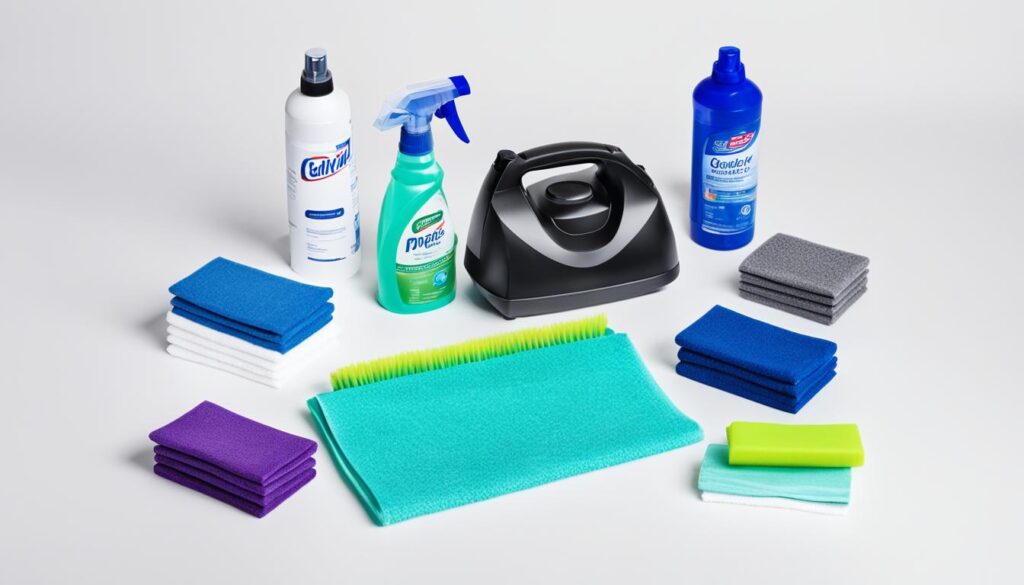
Having the right cleaning accessories and supplies not only makes the cleaning process easier but also ensures that your heat press is properly maintained and operates at its best.
Whether you choose to purchase these cleaning accessories or create your own DIY alternatives, having these tools at your disposal will make heat press cleaning a breeze. Keep your heat press performing optimally by investing in high-quality cleaning accessories and regularly maintaining its cleanliness.
Specific Cleaning Instructions for Cricut EasyPress
If you own a Cricut EasyPress, it’s essential to follow specific cleaning instructions to maintain its performance and longevity. The heat plate of a Cricut EasyPress is made of aluminum with a ceramic non-stick coating, requiring proper care and cleaning techniques.
To clean the heat plate, you can use commercially available iron cleaner specially formulated for non-stick surfaces. Gently apply the cleaner to a soft cloth or sponge, and wipe the heat plate in a circular motion. Avoid using abrasive materials or cleaners that can damage the non-stick coating.
In addition to cleaning the heat plate, it’s important to protect your work surface and keep the Cricut EasyPress Mat clean. The Cricut EasyPress Mat serves as a protective barrier and can be easily cleaned to remove any residue or ink transfer.
Cleaning the Cricut EasyPress Mat
Follow the manufacturer’s guidelines for cleaning the Cricut EasyPress Mat. Typically, you can spot clean the mat with mild soap and water. Gently scrub any stains or residue using a soft brush or sponge. Rinse thoroughly and allow the mat to air dry before using it again.
Proper Maintenance of the Heat Press Pad
The heat press pad, which is used in conjunction with the Cricut EasyPress Mat, also requires regular cleaning. Generally, the pad can be wiped clean with a damp cloth or sponge. For stubborn stains or residue, consider using mild soap and water. Allow the pad to air dry completely before using it again.
By following these specific cleaning instructions for the Cricut EasyPress and its accessories, you can ensure optimal performance and maintain the longevity of your heat press. Regular cleaning and maintenance will help you achieve consistent and professional-quality heat transfers, allowing you to unleash your creativity with confidence.

Next, we will explore important cleaning tips for different heat press sizes, ensuring that you can effectively clean any type of heat press machine.
Cleaning Tips for Different Heat Press Sizes
Heat presses come in various sizes, and each size might require slightly different cleaning techniques. Whether you have a small heat press or a large one, the process of cleaning the heat plate remains the same. However, you may need to pay extra attention to the corners and edges of larger heat press machines. A clean heat press platen ensures that your transfers are evenly applied, resulting in professional-quality results.
| Heat Press Size | Cleaning Tips |
|---|---|
| Small |
|
| Large |
|
Remember, regardless of the size of your heat press, it’s crucial to clean the heat plate regularly to maintain optimal performance and achieve consistent results. By implementing proper cleaning techniques, you can ensure that your heat press operates at its best and delivers professional-quality transfers.
Cleaning Techniques for Sticky Transfers
If you encounter sticky transfers or residue buildup on your heat press, there are specific cleaning techniques you can use. One method is to heat the sticky area with the heat press, then use a lint-free cloth or scraper to gently remove the residue. You can also try using heat press cleaning solutions or adhesive removers specifically designed for this purpose.
Sticky transfers can be a common issue when working with heat presses, especially if you’re using materials like vinyl or heat transfer adhesive. These substances can sometimes leave behind residue on the heat plate, affecting the quality of your transfers.
Here’s a step-by-step guide on how to clean sticky transfers from your heat press:
- Turn off the heat press and allow it to cool down completely.
- Identify the areas with sticky residue.
- Heat the heat press to a low temperature, typically around 100-150 degrees Fahrenheit.
- Once heated, place a lint-free cloth or scraper on the sticky area and gently apply pressure.
- Move the cloth or scraper across the sticky area, using light strokes to remove the residue.
- Repeat this process as necessary until the sticky residue is completely removed.
- If the residue is particularly stubborn, you can try using a heat press cleaning solution or adhesive remover. Apply a small amount of the solution to the residue and gently wipe it away with a clean cloth.
Remember to always follow the manufacturer’s instructions when using cleaning solutions or adhesive removers to ensure proper usage and safety.
Cleaning sticky transfers from your heat press is crucial for maintaining the longevity and performance of your machine. By regularly cleaning and removing residue, you can ensure that your transfers are clean and professional-looking every time.
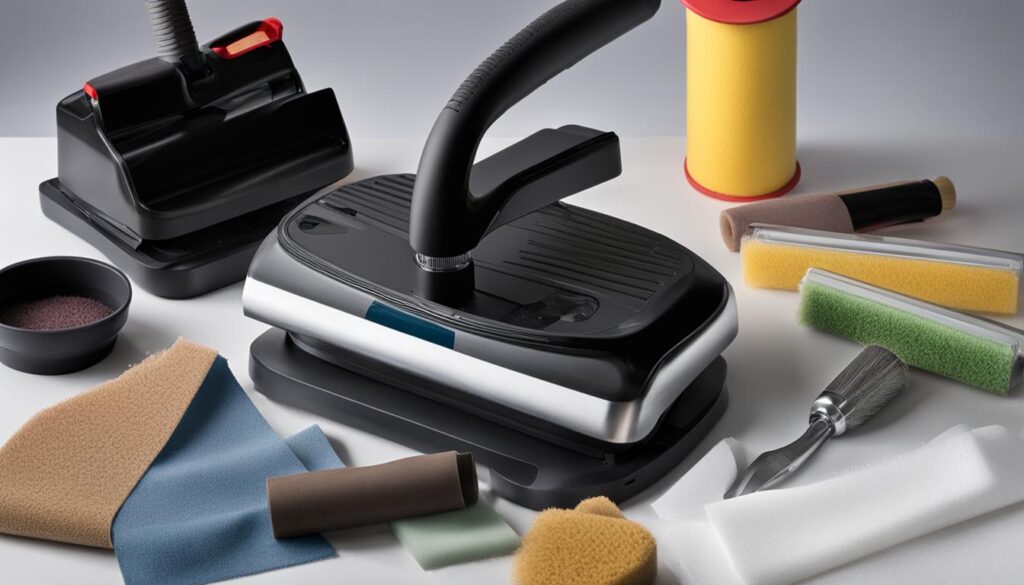
Maintenance Tips for Teflon-Coated Heat Presses
Teflon-coated heat presses require special care and maintenance to ensure their longevity and optimal performance. The Teflon coating on the heat press surface is delicate and must be handled with caution to avoid damage. Here are some best practices for cleaning a Teflon-coated heat press machine:
Avoid Abrasive Cleaners
Avoid using abrasive materials or harsh cleaners that can scratch or degrade the Teflon coating. Instead, opt for mild soap and warm water to gently clean the surface. Using a soft cloth or sponge, apply the soapy water and wipe away any stains or residue. Remember to be gentle and avoid excessive scrubbing to maintain the integrity of the Teflon coating.
Consider Non-Abrasive Solvents
If mild soap and water are not sufficient to remove stubborn stains or residue, you can use a non-abrasive solvent like mineral spirits. Apply a small amount of the solvent to a cloth and gently wipe the affected area. Be sure to follow the manufacturer’s instructions and test the solvent on a small, inconspicuous area of the heat press before applying it to the entire surface.
Inspect for Wear or Damage
Regularly inspect the Teflon coating for any signs of wear or damage. Over time, the Teflon coating may start to wear off or develop scratches. If you notice any areas where the coating has deteriorated, it’s essential to address them promptly. Continued use of a heat press with damaged Teflon coating can lead to uneven heat distribution and poor transfer quality.
Consider Teflon Spray for Added Protection
To provide additional protection to the Teflon coating and enhance its longevity, you can consider applying a Teflon spray. This spray creates a thin, protective layer on the Teflon surface, making it easier to clean and reducing the risk of stains or residue buildup. Follow the manufacturer’s instructions and apply the Teflon spray as recommended for optimal results.
By following these maintenance tips, you can ensure that your Teflon-coated heat press machine remains in excellent working condition and delivers consistent, high-quality heat transfers.
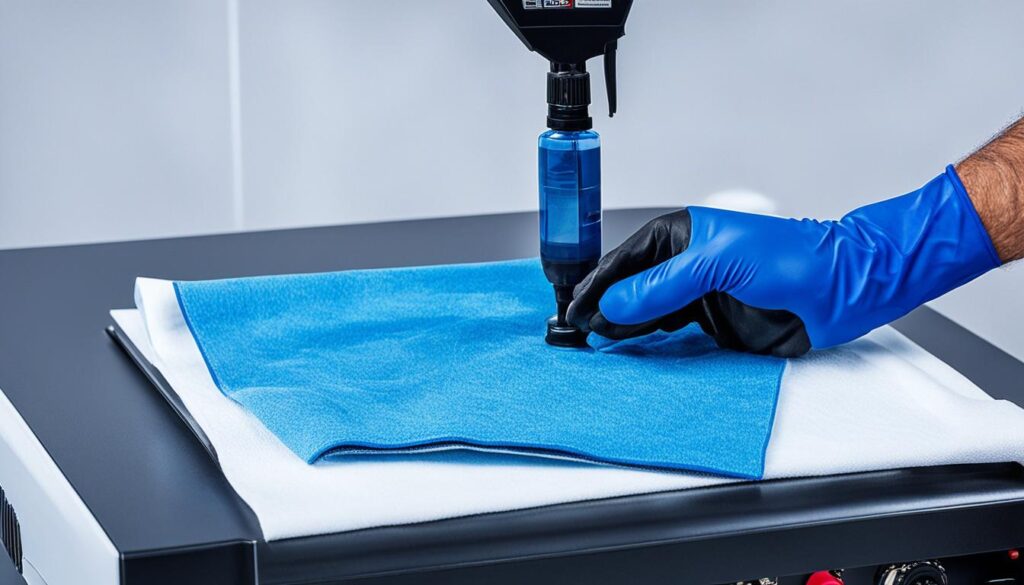
Test Your Heat Press After Cleaning
After thoroughly cleaning your heat press, it’s important to perform a test press to ensure that it is functioning optimally. This step is crucial in removing any residue from the heat press and maintaining the cleanliness of the plates. By following this simple and effective test, you can identify any potential issues that may affect the quality of your transfers.
- Start by turning on your heat press and allowing it to reach the desired temperature for your transfer.
- Once the heat press is hot, take a clean cloth or Teflon sheet and place it on the bottom plate.
- Close the heat press and apply moderate pressure to ensure even heat distribution.
- Leave the cloth or Teflon sheet in the heat press for a few seconds before removing it.
- Inspect the cloth or Teflon sheet for any residue or debris. If there are any visible remnants, repeat the cleaning process or use a non-abrasive cleaning solution to remove them.
By performing a test press, you can be confident that your heat press is clean and ready for your next project. This step ensures that your transfers will adhere properly and produce high-quality results. Remember to regularly clean your heat press to maintain its performance and extend its lifespan.

Conclusion
Regular cleaning and maintenance of your heat press machine are vital for achieving optimal performance and maximizing its lifespan. By following the tips and techniques outlined in this guide, you can keep your heat press clean and in excellent working condition.
Remember to clean the heat plate regularly to remove any residue or built-up ink that can affect the quality of your transfers. Use a non-abrasive cleaner and a soft cloth or t-shirt to gently wipe the surface. If you’re working with sublimation ink, make sure to remove it using isopropyl alcohol or a sublimation ink remover.
Additionally, protect your surface and prevent any damage to your work area by using a heat press mat or cover. These accessories not only provide a barrier between the heat press and your transfers but also make cleaning easier. Make sure to also implement proper maintenance practices such as lubricating moving parts and inspecting the machine for any signs of wear or damage.
By taking these steps and practicing regular cleaning and maintenance, you’ll enjoy consistent and high-quality heat transfers for years to come. Good luck!
FAQ
How often should I clean my heat press machine?
It is recommended to clean your heat press machine after every use. Regular cleaning helps maintain optimal performance and prevents residue buildup.
What should I use to clean the heat plate of my heat press?
You can use a soft cloth or t-shirt dampened with mild soap and water to clean the heat plate. For stubborn residue, a commercially available iron cleaner can be used.
Can I use abrasive cleaners to clean the heat plate?
No, abrasive cleaners can damage the heat plate’s surface. It is best to use non-abrasive cleaners like mild soap and water or commercially available iron cleaners.
How can I protect the surface of my heat press machine?
You can protect the surface of your heat press machine by using a heat press mat or cover. These accessories provide a barrier between the heat press and transfers, absorbing excess heat and preventing damage to your work surface.
How do I remove sublimation ink from my heat press?
To remove sublimation ink, turn off the heat press and let it cool down. Then, use a cloth dampened with isopropyl alcohol or a sublimation ink remover to gently wipe away the ink. Avoid rubbing too hard or using abrasive materials.
Why is proper pressure and heat distribution important for heat press performance?
Proper pressure and heat distribution ensure that your transfers are applied evenly and consistently. Cleaning the heat press regularly helps maintain these essential factors for optimal performance.
How should I clean the exterior of my heat press machine?
Use a cloth dampened with mild soap and water to wipe down the outer surfaces of your heat press machine. Avoid getting water or cleaning solution inside the machine or on the electrical components.
How should I store my heat press when not in use?
Store your heat press in a clean and dry area, preferably covered to protect it from dust and other contaminants. Perform regular maintenance tasks such as lubricating moving parts and inspecting for wear or damage.
What cleaning accessories and supplies do I need for my heat press?
Essential heat press cleaning supplies include cleaning solutions, lint-free cloths, and scrub brushes. These tools make the cleaning process easier and more effective.
How do I clean my Cricut EasyPress?
To clean the heat plate of your Cricut EasyPress, use commercially available iron cleaner. You can also use a Cricut EasyPress Mat to protect your work surface and make cleaning the mat easier. Follow the manufacturer’s guidelines for cleaning the mat and pad.
Do different heat press sizes require different cleaning techniques?
The cleaning process for the heat plate remains the same regardless of the heat press size. However, larger heat press machines may require extra attention to the corners and edges.
How can I remove sticky residue from my heat press?
One method is to heat the sticky area with the heat press, then use a lint-free cloth or scraper to gently remove the residue. Heat press cleaning solutions or adhesive removers can also be used for this purpose.
How do I clean a Teflon-coated heat press?
Avoid using abrasive materials or cleaners that can damage the Teflon coating. Instead, use mild soap and warm water or a non-abrasive solvent like mineral spirits to clean the surface. Regularly inspect the Teflon coating for wear or damage and consider applying a Teflon spray for added protection.
Should I test my heat press after cleaning?
Yes, it is recommended to perform a test press after cleaning to ensure that the heat press is functioning properly. This allows you to check for any remaining residue or debris on the heat plate and verify consistent pressure and heat distribution.
